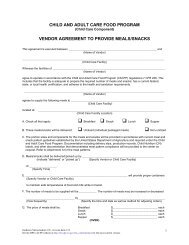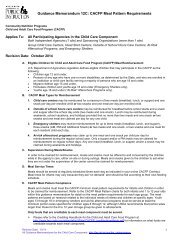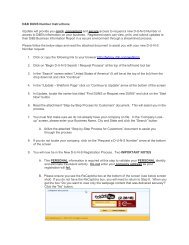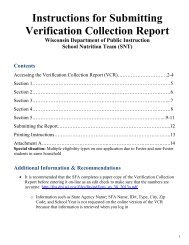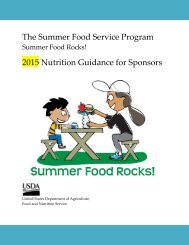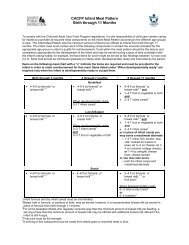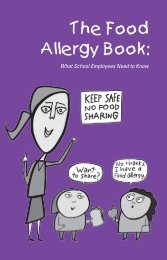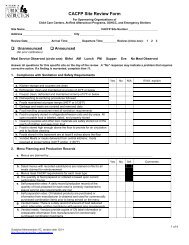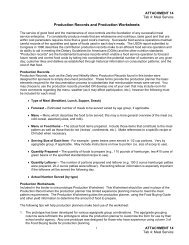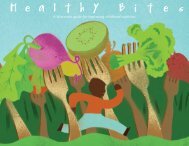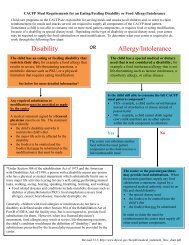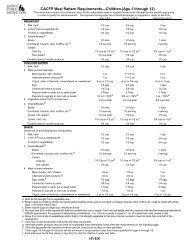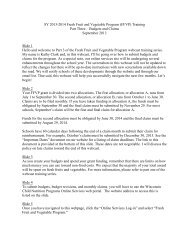Spring - WI Child Nutrition Programs (FNS)
Spring - WI Child Nutrition Programs (FNS)
Spring - WI Child Nutrition Programs (FNS)
Create successful ePaper yourself
Turn your PDF publications into a flip-book with our unique Google optimized e-Paper software.
CN Labels<br />
Do you know what CN Labels are? Do you know what a CN<br />
Label looks like? Let’s take a closer look at this specific label<br />
and how the use of CN Labels may benefit your food program.<br />
What is the <strong>Child</strong> <strong>Nutrition</strong> Labeling Program?<br />
The <strong>Child</strong> <strong>Nutrition</strong> (CN) Labeling Program is a voluntary<br />
USDA labeling program for the <strong>Child</strong> <strong>Nutrition</strong> <strong>Programs</strong><br />
(CNP); the <strong>Child</strong> and Adult Care Food Program is a CNP. Since<br />
it is voluntary, you will not find the CN Label on all products.<br />
The USDA evaluates a product’s formulation (exactly what the<br />
product is made from) to determine how it will contribute<br />
towards the meal pattern requirements. Once approved, the<br />
manufacturer is allowed to state this contribution on the label.<br />
What products are eligible for CN labels?<br />
Only two types of products can have CN labels; however the<br />
products may contribute to other meal components such as<br />
meat/meat alternates, bread/grains or fruits/vegetables.<br />
• Main dish products which contribute to the meat/meat<br />
alternates component of the meal pattern requirements.<br />
Examples include cheese or meat pizzas, meat/cheese and bean<br />
burritos, chicken nuggets, meat or cheese ravioli, egg rolls, beef<br />
patties, and breaded fish portions.<br />
• Juice and juice drink products containing at least 50 percent<br />
full-strength juice by volume. This includes such products as<br />
grape drink, fruit punch and frozen juice drink bars.<br />
Are CN labeled products better than similar non-CN labeled<br />
products?<br />
No, a CN Label does not indicate that the CN product is<br />
healthier or more nutritious than a similar non-CN Labeled<br />
product. It also does not indicate that the quality of the food is<br />
any different than a non-CN Labeled food. The CN label<br />
declares the quantities of the creditable food items in a processed<br />
food and how they contribute to the meal pattern requirements.<br />
What are the advantages of using CN labeled Products?<br />
• A CN label statement clearly identifies the contribution of a<br />
product toward the meal pattern requirements, and it protects<br />
you from exaggerated claims about a product.<br />
• A CN label provides a warranty against audit claims if the CN<br />
labeled product is used according to the manufacturer’s<br />
directions.<br />
• A CN label simplifies cost comparison of similar products.<br />
How do I identify a CN labeled product?<br />
Look at the sample CN label below. A CN labeled product will<br />
always contain the following:<br />
• The CN logo, which is a distinct border with CN written on all<br />
four sides<br />
• The meal pattern contribution statement<br />
• A unique six-digit product identification number (assigned by<br />
<strong>FNS</strong>) appearing in the upper right hand corner. In our example,<br />
the identification number is 000000; however, all zeroes does<br />
NOT represent a valid CN Label identification number<br />
• The USDA/Food and <strong>Nutrition</strong> Service (<strong>FNS</strong>) authorization<br />
statement<br />
• The month and year <strong>FNS</strong> gave final approval appears at the<br />
end of the authorization statement, in our example it shows<br />
09/04<br />
Beef Ravioli (Canned)<br />
CN<br />
000000*<br />
Contents of this can (108 oz) provide<br />
13.50servings (8.00 oz by weight). Each 8.00<br />
oz serving (containing 8 pies and sauce) of<br />
Beef Ravioli made with Enriched Macaroni<br />
CN Product with Fortified Protein provides 2.00 CN<br />
oz equivalent meat/meat alternate for <strong>Child</strong><br />
<strong>Nutrition</strong> Meal Pattern Requirements. (Use of<br />
this logo and statement authorized by the<br />
Food and <strong>Nutrition</strong> Service USDA 09/04)<br />
CN<br />
The beef ravioli CN label shows the can contains 13.5 servings<br />
when 2.0 ounces of meat/meat alternate are required for the<br />
lunch meal pattern. <strong>Child</strong>ren 6 to 12 years of age would need 8<br />
pies. Also, notice that 8 pies will weigh 8.0 ounces (that is a ½<br />
pound!), an ounce a piece. That also means one pie contains only<br />
¼ ounce of meat/meat alternate. How much would you have to<br />
serve for children 3 to 5 years of age? They need 1.5 ounces for<br />
lunch. If 2 ounces equals 8 pies, then 6 pies would meet the<br />
lunch meal pattern requirements for 1.5 ounces. Based on this<br />
information, would this product be an acceptable product for<br />
your child care center? The product definitely could meet the<br />
meal pattern requirements for the children. However, after<br />
reviewing this product, the size of the portions would definitely<br />
be unrealistic for the age of the children. The cost per serving<br />
may also be prohibitive since you get so few servings per can.<br />
When planning menus with combination foods, such as the beef<br />
ravioli, spaghetti and meat sauce, beef stew, or breaded chicken<br />
patty, you have to ensure each portion served meets the meal<br />
pattern requirements for lunch for the age of the children. In<br />
order to do that, you either need to 1) prepare the product from<br />
scratch using a written recipe that lists the weight of meat/meat<br />
alternate to be used, the number of portions, and serving size to<br />
meet the meal pattern requirement; or 2) if you are looking for<br />
convenience you must either purchase a CN Labeled product or<br />
request a product formulation sheet or product analysis sheet<br />
signed by an official of the manufacturer (not a salesperson)<br />
stating the amount of meat/meat alternate in the product. Call<br />
the 1-800 number on the package and ask for a manufacturer’s<br />
analysis sheet. This will provide the same information as a CN<br />
label.<br />
USDA Memos<br />
Recently issued Guidance Memos from USDA include:<br />
Memo No. Title<br />
07-2010 Eligibility of Haitian Refugees for the <strong>Child</strong> <strong>Nutrition</strong><br />
<strong>Programs</strong><br />
A link to the memos can be found on our website under USDA<br />
CACFP Policy Memos at: http://dpi.wi.gov/fns/cacfp1.html<br />
2 CACFP Today



